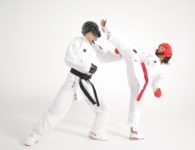
Are you thinking about enlisting an untrained partner in your at-home martial arts practice? We’ve got some tips to make this new martial arts training experiment effective, safe, and fun for both of you.
Most of us aren’t lucky enough to be sheltering in place with fellow martial artists and training partners. But many of us might be fortunate enough to have someone — like a partner, parent, sibling, or roommate — in our lives who might be willing to help us out with our martial arts training with the right guidance and encouragement.
Even in better times, being able to work with an untrained partner is a valuable skill for any martial artist to have. It can open up a whole new world of training options for you while traveling away from your gym, or during holidays when the dojo might be closed. It can also expand your new training partner’s horizons. If someone is curious about martial arts, but too nervous to join or a gym or sign up for a trial class right away, doing a little bit of a training with you could be a comfortable first step for them.
Whatever your situation, and whatever you and your brand new martial arts training partner’s goals are, these ideas will get you started.
Participate in Parallel Play
If your new training partner isn’t ready to actually train martial arts with you right away, you can always start by doing single-person martial arts and conditioning drills (like our Solo Martial Arts Drills You Can Do At Home) next to each other. It might not be quite the same as doing partner drills or sparring at the gym, but you will get the benefit of having company and mutual encouragement. If space or equipment are issues, you can also build rounds or circuits together. For example, if you have one jump rope, you can skip for a two or three minute round while your partner does bodyweight exercises or an active recovery move like lightly marching in place. When the bell or timer goes, you switch! Or one person can do solo grappling drills on a mat while the other rests and coaches. Or one person can do shadow boxing or kickboxing with boxing gloves, weighted gloves and/or ankle weights, and vice versa.
Even if your untrained partner never wants to progress past this stage, your workouts just got a lot less lonely and a lot more fun!
Get Them To Watch You
If your new training partner is willing to get a little involved with your training, but isn’t quite sure if they want to fully participate in your martial art yet, there’s a lot of middle ground that you can explore together. You can explain a technique to them, then have them watch you perform it while offering their thoughts on what you’re doing. It’s always helpful to have another eye on your form to help you tackle aspects of your game that you might not be able to notice when you’re training alone. It’s also possible that someone who doesn’t train in your martial art might be able to offer a fresh new outside perspective to help you look at your technique in all new and challenging ways.

Teach Them How To Coach You
If your person is open to getting more hands-on with your training, you can also start incorporating them into your drills. As long as you start slowly and carefully, and teach them how to properly perform their end of the drills in a way that will keep them safe and keep you challenged, an untrained partner can be an amazing step between solo training and the kind of partner training you’d find in an actual martial arts class. Your new training buddy might not be able to spar with you or help you execute intense drills (Please don’t make them try that. Imagine how scared you would have been if you’d been thrown into intense competition training on your first day!). But they can offer you different resistance, feedback, and motivation than a heavy bag or a grappling dummy would.
If you’re a martial artist focusing on striking training in Boxing, Kickboxing, Karate, Tae Kwon Do, and more, you can start by teaching your untrained partner how to hold focus mitts, Thai pads, a foam body shield, or hand paddles for basic strikes and combos.
If you’re working on your grappling, you can show them how to perform the less active half of positional drills, like sitting on their knees and holding their arms out so that you can practice arm bar drills on them, or holding the turtle position so you can work on your back spin drill.
And, if they enjoy helping you with those drills, offer to hold focus mitts or get into drilling position while they try them out!
Teach Them A Technique
If your non-martial artist training partner starts expressing more interest, you can also begin to explain techniques to them. In addition to promoting your martial art and sharing something new and fun with a friend or family member, you’ll also improve your own game. Teaching someone else is one of the best ways to learn. It’s part of why instruction is an important part of higher belt rankings in many martial arts. So ask them what they want to learn. Hold the pads or set up the drill for them. Answer any questions they might have with patience and enthusiasm. And enjoy the benefits of training with a loved one together!

Looking for more at home training ideas? Check out our blog posts:
- At-Home Workouts: 7 Types of Cardio Training You Can Do At Home
- Solo Martial Arts Drills You Can Do At Home
- Four Boxing Drills You Can Practice at Home With No Sparring Partner
- 5 Workouts You Can Do in the Comfort of Your Own Home
- How to Spar With Your Mattress and Other Home Workout Tips From MMA Fighters
- Martial Arts Training At Home: How To Build and Use Your Own Makiwara
- How To Train With A Focus Mitt Stand
- Training at Home: Checking in With Some of AWMA’s Favorite Martial Artists
- Martial Arts Training At Home: How To Build And Use Your Own Chi-ishi



















